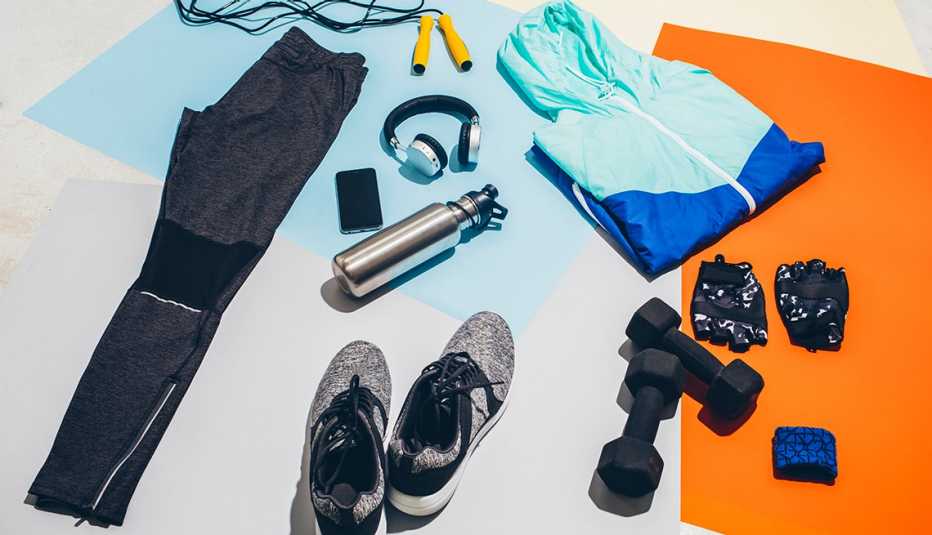AARP Hearing Center


The secret to improving your health — according to doctors and decades of research — is to make simple, healthy choices each and every day. To help you do just that, we’ve gathered an array of 34 diet, fitness and lifestyle-related suggestions. Try some now, try some later. Over time, regularly incorporating these habits may help you live and feel better.


FUEL YOUR BODY
1. Eat more veggies
A plant-based diet (as opposed to a diet heavy on meats and refined carbs) has been linked to lower blood pressure, cholesterol and diabetes risk. Think you’ll sacrifice too much eating pleasure? Remedy that by visiting a high-quality vegetarian restaurant and sampling a few dishes. Vegetarian chef Kate Jacoby, owner of the restaurant Vedge in Philadelphia, notes that ancient grain-based proteins such as seitan have a similar texture to meat, and seared portobello mushrooms have the same sort of umami flavor that makes steak so satisfying. Both ingredients are relatively inexpensive and easily prepared at home. Or simply try one of the meatless burgers offered at many fast-food and family restaurants. Companies, seeing a growing market for health food, are responding by offering vegetables in creative new ways, such as zucchini noodles, cauliflower pizza crust or riced squash. Many cost just a few dollars; give them a try.
2. Put more fish on your dish
Studies have linked the Mediterranean diet to reduced cholesterol levels and a lower risk of cardiovascular disease and memory loss. Though the diet focuses on consuming mostly plant-based foods such as fresh fruits, vegetables and whole grains, it also promotes eating fish. “Lean meats such as fish have the fewest calories per ounce, when compared with steak and chicken — so when you are eating out, picking the fish entrée is a delicious and healthier alternative,” says Joyce Gomes-Osman, vice president of clinical development at Linus Health. She notes that it's best to choose fish that are lower in mercury, such as sardines and salmon. These will give you the added benefit of consuming omega-3 fatty acids, which are associated with lower levels of inflammation.
3. Make fiber your friend
It’s well known that consuming fiber can help keep you regular, but studies have also shown that a fiber-rich diet may lower your risk for certain diseases such as colorectal cancer. For diabetics, there’s evidence that a high-fiber diet improves blood glucose levels. The Cleveland Clinic recommends eating a mix of foods rich in both soluble and insoluble fiber, and advises that men over 50 consume 30 grams daily and women over 50 consume 21 grams. Soluble options include apples, barley, beans and citrus fruits; and insoluble foods include nuts, whole-wheat flour, berries and vegetables such as cauliflower, green beans and carrots. You don’t have to overhaul your whole diet to beef up your fiber intake. Small changes can make a big impact, and it’s important to slowly increase your intake to let your body adjust — and drink plenty of water to help with absorption. For example, snack on nuts and dried fruit, add a few tablespoons of unprocessed wheat bran to your favorite cereal, swap your white rice for brown, add a few kidney beans to canned soup, and sprinkle in a little uncooked oatmeal when you bake muffins or cookies.
4. Choose water for the win
It might seem obvious to skip sodas or juice products that have sugar, corn syrup or other added sweeteners. But even drinks that contain no- or low-calorie sweeteners may have health risks. “Our research and other observational studies have shown that artificially sweetened beverages may not be harmless, and high consumption is associated with a higher risk of stroke and heart disease,” says Yasmin Mossavar-Rahmani of the Albert Einstein College of Medicine in the Bronx, New York. All the more reason to choose water (or, if you prefer, sparkling water) as your primary drink throughout the day.
5. Make time for tea
Drinking water is the best way to stay hydrated, but adding a cup or two of tea can be beneficial. Yuko Hara, neuroscientist and director of aging and Alzheimer's prevention at the Alzheimer's Drug Discovery Foundation, recommends unsweetened green tea. “Unsweetened green tea is associated with reduced risk of dementia, cardiovascular disease, diabetes and some cancers,” she says. Hara notes that it’s better to drink green tea earlier in the day because it contains caffeine, which can interfere with sleep.
6. Restrict your eating hours
A recent trend in diet and nutrition circles is intermittent fasting, which reduces the number of hours in a day that you allow yourself to eat. One form, called early time-restricted feeding, means you only eat the first eight to 10 hours a day. Though some programs may be difficult to follow, a sensible approach would be to implement a “no more food after 7 or 8 p.m. each evening” rule. The benefits are more than just fewer calories and, therefore, weight loss; it also helps improve your metabolism.


BOOST YOUR FITNESS
7. Take a stand
Merely getting up from your chair every 30 minutes and taking a few moments to walk around can reduce some of the long-term health consequences of sitting for prolonged periods, according to a study in the Annals of Internal Medicine. Switch to a standing desk or set an alarm to remind you to get up and move. “Do whatever it takes to send the message that your job is to get up and move,” says Prianka Chawla, a primary care physician at Tufts Medical Center.
8. Wake up and walk
Daily aerobic fitness is particularly important as you age. One way to start your day off on the right foot is to take a 30-minute walk first thing in the morning. You can ease into this plan by setting your alarm 15 minutes earlier than usual; then the following week, set it another 15 minutes earlier, and double your walk length. And studies have shown that starting your day outside can help you sleep better at night. Natural sunlight exposure can help keep circadian rhythms in balance.
9. Have a backup plan
Gomes-Osman notes that many adults want to start a healthy behavior but don’t always understand how to keep it going. “Three critical ingredients of successful behavior change [many people lack are]: self-efficacy (the likelihood to keep going when faced with an obstacle), self-regulation (troubleshooting obstacles) and social support. So if you’ve chosen to walk or jog outside, spend a few minutes planning what you will do if it rains," she says. Search for YouTube exercise videos or download some workout apps that you can try, so you can stay active no matter the weather.
10. Stretch for success
Not inclined toward a morning walk? Maybe try doing a handful of yoga poses after you roll out of bed. “Practicing yoga is helpful for increasing energy, improving flexibility and promoting whole-body strength, which can ward off the aches and pains that can zap your desire to get up and go,” says Kate Hanley, author of Stress Less: Stop Stressing, Start Living. Beginner yoga poses to consider include the Mountain, the Sphinx, the Cobbler, the Tree and the Downward Facing Dog. Research shows that yoga can provide mental health benefits for older adults, and it also improves your posture. “Practicing yoga can also have positive effects on cognitive functions such as attention, processing speed and executive functions,” Hara adds.
11. Release daily tension
As you go through your day, you may find that you accumulate tension and stress in your body. Shirley Chock, a certified corporate wellness specialist, says it’s important to make sure you discharge that tension, because it can contribute to ongoing aches and pain. “Clenching your jaw for too long will cause tension headaches. If you notice your jaw is clenched, run your tongue along your teeth to loosen up the jaw. Notice if your shoulders are tight and shrugged. Lift your arms up over your head and let them relax and drop down and shake them out. The vibrations from swinging and shaking muscles will instantly dissolve tension. Notice the tension in your chest. Soften your chest to facilitate slower, deeper breathing which will help alleviate tension," she says.
12. Head outside
Studies show that spending two hours in nature every week can have a measurable impact on your health. “In the winter months, getting [mood-boosting] vitamin D is so important,” says Teresa Jordan, a physician assistant at the Mayo Clinic. If you need some encouragement, volunteer as a dog walker with the Humane Society.




































































More AARP Smart Guides
Dry January
Tips to help you succeed at the monthlong sobriety challenge
Sleep Better
How to fight restless nights and get the slumber you need
Choices for a Healthy Heart
Treat your heart right with these easy, research-proven ideas
More Members Only Access